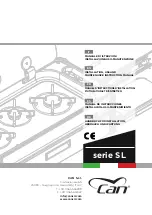
6
always place the griddle on the grate before turning on the burner.
always use potholders to remove the griddle from the grate. allow the griddle to cool before
removing. Do not set hot griddle on surfaces that cannot withstand high heat such as countertops.
Be sure the griddle is positioned correctly and is stable before use to prevent hot spills and
possible burns.
Using the Griddle
Before first use:
• Wash Griddle in hot soapy water. Rinse and then dry completely.
• Apply a thin coat of vegetable oil to the entire surface (front and back of griddle).
• Preheat your oven to 350°F. Place the griddle on the upper rack in your oven.
• Bake griddle for 1 hour at 350°F, then turn oven OFF and let cool before removing.
• The surface may appear to have a tacky feel to it from this seasoning process. If desired, wash
the griddle in hot soapy water, rinse well, and dry completely.
after each use:
• To prevent rusting, store in a dry place and keep uncovered.
• After each use, clean with a stiff brush and hot water only.
• DO nOT ClEan GriDDlE in DisHWasHEr.
• Dry immediately and apply a light coating of vegetable oil to griddle before storing.
Using the Griddle:
• Place either side of the griddle centered over the left side gas burners.
• Preheat the griddle for 5 minutes on medium to medium low setting. Slow preheat ensures even heat distribution during
the cooking process.
• DO NOT preheat the griddle on HI setting. Preheating on HI may warp the griddle and prevent even heat distribution.
surface Cooking
Use Proper Cookware
Cookware should have
flat bottoms that make
good contact with the
entire surface heating
element. Check for
flatness by rotating a
ruler across the bottom
of the cookware (See
Figure 1). Be sure
to follow the recommendations for using
cookware as shown in Figure 2.
note: The size and type of cookware used
will influence the setting needed for best
cooking results.
note: Always use a utensil for its intended
purpose. Follow manufacturer's instructions.
Some utensils were not made to be used in
the oven or on the cooktop.
* Specialty pans such as lobster pots, griddles and pressure cookers may be
used but must conform to the above recommended cookware requirements.
COrrECT
• Flat bottom and straight sides.
• Tight fitting lids.
• Weight of handle does not tilt
pan. Pan is well balanced.
• Pan sizes match the amount of
food to be prepared.
• Made of material that conducts
heat well.
• Easy to clean.
inCOrrECT
• Curved and warped pan bottoms.
• Pan overhangs unit by more than
2.5 cm (1”).
• Heavy handle tilts pan.
• Flame extends beyond unit.
Figure 2
Figure 1
DO nOT use a wok if it is equipped
with a metal ring that extends beyond
the burner unit. Because this ring
traps heat, the surface unit and
cooktop surface could be damaged.
Using a wok
Woks
with flat bottoms suitable for use on your
cooktop are available in most cookshop or
hardware stores. Round-bottomed woks (with
a support ring that does not extend beyond the
burner unit) may also be used. The metal ring
was designed to support the wok safely when
it is filled with large amounts of liquids (soup
making) or fat (frying).
Wire trivets:
Do not use wire trivets. Cookware
bottoms must be in direct contact with the
grates.
































